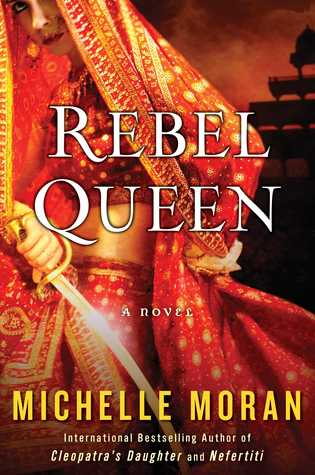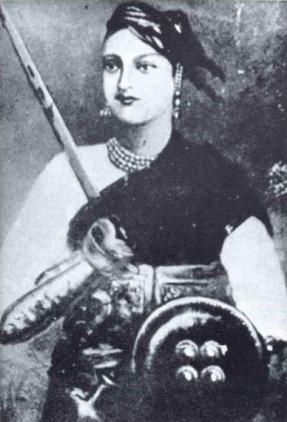Book: Rebel Queen
Author: Michelle Moran
Advanced Reader’s Copy (ARC) – Courtesy of Goodreads Giveaway
Pages: 386
Genre: Historical Fiction, Indian Literature, 19th Century Literature, Adult Fiction
Description from Goodreads:
“When the British Empire sets its sights on India in the 1850s, it expects a quick and easy conquest. After all, India is not even a country, but a collection of kingdoms on the subcontinent. But when the British arrive in the Kingdom of Jhansi, expecting its queen to forfeit her crown, they are met with a surprise. Instead of surrendering, Queen Lakshmi raises two armies—one male, one female—and rides into battle like Joan of Arc. Although her soldiers are little match against superior British weaponry and training, Lakshmi fights against an empire determined to take away the land she loves.
Told from the perspective of Sita, one of the guards in Lakshmi’s all-female army and the queen’s most trusted warrior, The Last Queen of India traces the astonishing tale of a fearless ruler making her way in a world dominated by men. In the tradition of her bestselling novel Nefertiti, which Diana Gabaldon, author of the Outlander series, called “a heroic story with a very human heart,” Michelle Moran once again brings a time and place rarely explored in historical fiction to rich, vibrant life.”
You know the old adage “Don’t judge a book by it’s cover?” I fully admit that I am guilty of this. All. The. Time. This is especially true when I’m perusing the giveaways listed on Goodreads – if the cover catches my attention, and the title is intriguing, I’ll read the description and then decide to add it to my “To Read” shelf. That is what happened with this book, “The Rebel Queen”. I was delighted to find out I won, and shortly after I was notified, I received my ARC in the mail.
The cover art is beautiful; the vivid reds and golds, and the mysterious looking woman definitely grabbed my attention. The title also piqued my interest – it made me want to learn more. (Pictured above is the cover on the ARC I received; according to Goodreads and Amazon, it’s the cover on the Hardcover book. The paperback has a different cover. Apparently, there is also a different title for the UK market – “The Last Queen of India”). As I said, I received the ARC; I believe the publishing date is March 2015.
I have always been interested in the culture and traditions of India, though I know very little about it. Because of this, I am not able to speak to how accurate things were – I do like that the author included a section in the back of the book to explain this; it’s important for an author to be honest with his or her audience and point out when certain items were added to flesh out the dialogue or enhance the story line, but it’s also important to make sure the true history isn’t compromised. I also loved that there is a glossary in the back of the book – pronunciations would have been awesome, but this is definitely a nice addition.
Let’s get to the story, shall we?
As the description mentions, the story is centered on the Indian Rebellion of 1857, and told from the perspective of Sita. In the book’s first few pages, we’re told she’s an elderly woman who has been convinced to share her story with…well, I can’t recall who it was. In fact, now that I’m looking back at things, it feels odd that this amazing story was just sandwiched between two scenes of this elderly woman surrounded by her diaries. I feel like it was more to set the stage for the tale to follow. Not a bad thing, it just feels odd now that I can’t really remember the specifics of it. Anyway – back to Sita – we basically follow her whole life, from childhood into her life with the rani, and a very brief look at life after the Rebellion. (Edited to add: I reread the first couple pages and the last few pages today – Sita was asked to share her story with Miss Pennywell, whose Grandfather is a publisher and is interested in stories about the colonies. The last couple of pages end with Sita reflecting on the events and sums up what life she had after serving the rani. I have a feeling I skimmed over those first few pages and just wanted to get to the heart of the story.)
The story is a little slow to get off the ground, if I’m honest. It doesn’t jump right into the action; instead if follows Sita and her struggles of fitting in to her own family, her tense and somewhat abusive relationship with her Grandmother (who loathes the fact that she’s a girl, and will never marry suitably for her position). We learn about Sita’s father, and her sister who plays an important role in Sita’s life. The most interesting aspect of this section of the book, in my opinion, is a look inside the life of an Indian village in which women observe purdah (basically female seclusion in both physical segregation from the men in the community, as well as keeping one’s self covered to conceal one’s form). Once certain events transpire, it is determined the only option Sita has in prospering in life and assisting her poor family is by training to become a candidate for the rani’s all-female guard. She trained day and night – both mentally and physically – and the day finally came when she was able to try out.
It’s not really a spoiler, though it kind of feels that way – Sita was accepted into the rani’s guard. The next section details her acclimation to life in the palace. It’s an interesting look into palace life, and the traditions and culture of the day. And as can be expected with that many girls in close quarters (literally!) there is girl drama! We also experience the birth of a child, a few deaths, and some traitorous behavior!
Eventually the story progresses to the real action – and it feels like thing just really happened too quickly. We reach the point where the British have taken over (not really a spoiler – its history!) and forced the rani and her court to move from the palace into a much smaller accommodations. And thus begins the decent into political unrest and battle. This section also details what happened to the surrounding villages, the women in those villages, and how the British treated the locals. It’s heartbreaking to see what happens to these women, especially Sita’s sister.
Overall, the story was VERY interesting to me, and I am definitely interested in learning more about Maharani Lakshmi Bai and that period of the East India Company. I liked the characters, and felt they were relatable and even found myself caring about them at pivotal moments throughout. The writing, I have to say, was a bit painful. While I realize there were explanations needed as a lot of this world is unfamiliar to most, I felt the language flitted between formal and informal in an awkward way. There were times the thoughts seemed to run together and sentences ran on forever – something I’m hoping will be cleaned up with the final edition (and ironic, since this review is very similar), and the passages seemed to be written as if they were fleeting thoughts – the patterns were fragmented. Again, I realize this is the ARC, and is an uncorrected proof, so I’m sure the final copy will be much more polished.
I’m very grateful for the opportunity to read this, and I’d say if you’re interested in 19th century history, Indian culture, strong female leads, and a good tale of love, intrigue, and action it’s work checking out.
Here is a photo of Rani Lakshmibai of Jhansi, if you’re interested 🙂

The Peach Martini Rating: 3 Martinis

